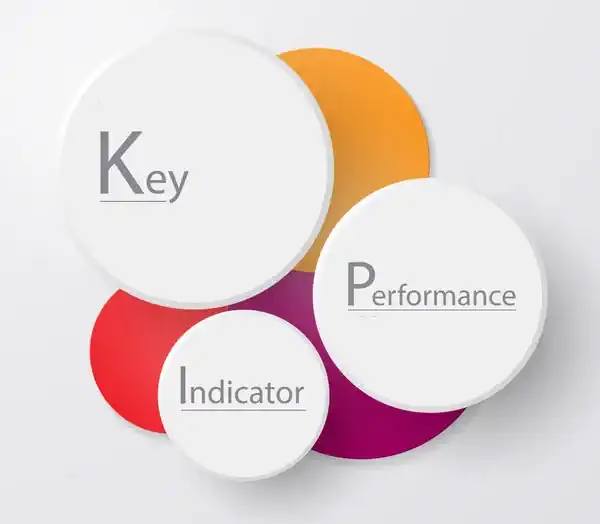Are you feeling like your business is stuck in the mud? Like you’re spinning your wheels but not getting anywhere? It might be time to start using KPIs to get your business moving forward. KPIs, or key performance indicators, are powerful tools used to measure the success of a business and identify areas where improvement is needed.

Let’s explore what KPIs are, why they’re important, and how you can use them to take your business to the next level. So, buckle up, and let’s get started!
What are KPIs?
Key Performance Indicators (KPIs) are measurable metrics used to measure the success of your business. They can be used to understand how well your business is doing, as well as identify areas for improvement. KPIs provide feedback and help you make data-driven decisions.
They can also be used to track the success of a particular campaign, product, or service. KPIs are important tools for data collection, helping you assess the progress of your business and measure successes more accurately.
KPIs provide a way to measure the performance of a company and can be used to compare performance with other companies in the same field. They are also helpful in identifying areas for improvement and setting performance goals.
Why are KPIs Important?
Understanding the importance of Key Performance Indicators (KPIs) can make all the difference in the success of your venture. For example, a company that tracked customer loyalty through KPIs was able to identify areas where they needed to improve, leading to increased customer satisfaction and a boost in revenue.
KPIs are a measurable way to assess the progress of a business or organization, allowing you to identify trends and measure the impact of changes you make. By tracking and analyzing KPIs, you can identify problems and areas for improvement, as well as track the performance of your company against competitors.
KPIs can also help you set realistic goals for future growth and success. Using KPIs to track progress and success can help you make informed decisions about investments and strategies that will benefit your business. This data-driven approach can help focus resources on areas that need improvement and provide insight into the overall performance of the company.
By understanding the importance of KPIs, you can gain a better understanding of what drives success and use this knowledge to develop sound strategies for achieving your business goals.
How to Identify Relevant KPIs
Identifying the right KPIs to track your progress and success is key to achieving your goals. Whether you’re a small business owner or a large corporation, assessing the cost benefits of different KPIs and how they’ll affect customer experience will help you identify the most relevant KPIs.
Let’s say you own a retail store and you want to measure the success of your business. You could set a KPI goal of increasing your sales by 10% over the next quarter.
To ensure you reach this goal, you can track the accuracy of your data – such as customer purchases, employee performance, and marketing efforts – to make sure you’re on track. By using KPIs, you can measure your progress and make the necessary changes to reach your goals.
Determine Your Goals
When considering which KPIs to track, the first step is to determine the key objectives of your business. Are you looking to increase sales? Improve customer satisfaction? Reduce costs? Once you have established your objectives, you can then look into the KPIs that will help you measure progress and success in relation to those objectives.

For example, if your main goal is to increase sales, you may want to measure your customer acquisition rate, repeat purchase rate, and average order value. If your goal is to reduce costs, you may want to track cost per acquisition, cost per customer, and cost per order.
Knowing which KPIs to track will give you the insight you need to make informed decisions as you strive to reach your goals.
Some Common KPIs
Key Performance Indicators (KPIs) are vital metrics used by companies to evaluate their success in reaching targeted business goals. Here are six examples of KPIs a company might use:
Net Profit Margin
This financial KPI measures the percentage of revenue that exceeds the company’s costs. It’s crucial because it shows how efficiently a company is converting sales into actual profit. Net Profit Margin is calculated by dividing net profit by revenue and multiplying by 100 to get a percentage. It provides insight into the overall financial health of the company, including its ability to manage expenses relative to earnings.
Customer Satisfaction (CSAT) Score
This KPI is used to gauge how satisfied customers are with a company’s products, services, or experiences. It’s typically measured through surveys where customers rate their satisfaction on a scale. The CSAT score is calculated by dividing the number of satisfied customers by the total number of customers surveyed, then multiplying by 100 to get a percentage. High CSAT scores can indicate strong customer loyalty and can contribute to repeat business and referrals.
Employee Turnover Rate
This measures the rate at which employees leave a company and need to be replaced within a specific period. High turnover can indicate problems with company culture, job satisfaction, or compensation. It’s calculated by dividing the number of employees who have left by the average number of employees, then multiplying by 100 to determine the percentage. Monitoring this KPI can help a company identify and address issues that contribute to high turnover rates.
Return on Investment (ROI)
This financial KPI measures the gain or loss generated on an investment relative to the amount of money invested. ROI is a key metric for understanding how effectively a company is using its capital to generate profits. It’s calculated by dividing the net profit from an investment by the cost of the investment, then multiplying by 100 to get a percentage. A high ROI means the investment’s gains compare favorably to its cost, indicating efficient use of capital.
Inventory Turnover Ratio
This operational KPI helps companies understand how quickly they are selling inventory. A high turnover ratio indicates that a company is selling goods rapidly and efficiently, while a low ratio can suggest overstocking or weak sales. It’s calculated by dividing the cost of goods sold by the average inventory during a certain period. This metric is crucial for managing cash flow, reducing holding costs, and optimizing inventory levels.
Lead Conversion Rate
This sales KPI measures the effectiveness of a company’s sales funnel, indicating the percentage of leads that convert into paying customers. It’s an essential metric for evaluating the efficiency of the sales process and marketing efforts. The Lead Conversion Rate is calculated by dividing the number of new customers acquired by the number of leads, then multiplying by 100 to get a percentage. A higher conversion rate suggests that a company is proficient at turning potential interest into actual sales.
These KPIs, among others, are essential tools for businesses to assess their performance across various aspects, enabling them to make informed decisions and strategize for future growth.
A Step-by-Step KPI

Using one of the examples above, setting up and running the Lead Conversion Rate KPI involves a series of steps that revolve around data collection, analysis, and optimization. Here’s a step-by-step guide a company could use to help effectively track and improve their Lead Conversion Rate:
1. Define Your Leads and Conversions
- Identify what constitutes a lead for your business. A lead could be anyone who fills out a form on your website, subscribes to a newsletter, or contacts your company to express interest.
- Define a conversion. Typically, this is when a lead makes a purchase, but it could also include signing up for a trial, scheduling a demo, etc., depending on your business model.
2. Set Up Tracking Systems
- Implement a Customer Relationship Management (CRM) system to track interactions with potential and current customers. This will help you identify when a lead converts.
- Use web analytics tools (like Google Analytics) to track online interactions and conversions. Ensure that you’re tracking conversions effectively by setting up goals or events that align with your conversion definitions.
3. Collect Data
- Gather data on leads. Record how many leads you’re generating within a specific time frame (monthly, quarterly, etc.).
- Track conversions. Monitor how many of these leads turn into customers according to your defined conversion event.
4. Calculate the Lead Conversion Rate
- Use the formula: (Number of Conversions / Number of Leads) * 100 = Lead Conversion Rate (%).
- Perform this calculation regularly to track changes over time, such as on a monthly or quarterly basis.
5. Analyze the Data
- Identify trends. Look for patterns in the data that might indicate what’s working and what’s not.
- Segment the data. Analyze conversion rates by different sources (social media, email, etc.), demographics, or behaviors to understand which are most effective.
6. Optimize Your Strategy
- Focus on high-performing channels. Allocate more resources to the marketing channels or strategies that are generating the highest conversion rates.
- Improve your sales funnel. Identify stages in your sales process where leads drop off and find ways to address these issues.
- Test and iterate. Continuously test different approaches to lead generation and conversion, such as A/B testing landing pages or sales pitches, and refine your strategy based on what works best.
7. Report and Communicate Findings
- Create regular reports to share with your team or stakeholders that highlight the Lead Conversion Rate and other key metrics.
- Use visuals. Graphs and charts can help illustrate trends and make the data more accessible.
- Offer insights and recommendations based on your analysis to improve decision-making.
8. Adjust Goals as Necessary
- Set realistic benchmarks for improvement based on historical data and industry standards.
- Be prepared to adjust your goals as you gain more insight into what’s achievable and what strategies are most effective.
By systematically tracking and analyzing its Lead Conversion Rate, a company can gain valuable insights into the effectiveness of its sales and marketing efforts, enabling the company to make data-driven decisions to optimize its conversion process.
How to Track and Analyze KPIs
Once you’ve identified those all-important KPIs, it’s time to start tracking them – and that’s where the fun really begins! Fun you say? Yes, the fun lies in using the data to make informed decisions that will drive your business’s growth and success.
![]()
When it comes to tracking your KPIs, it’s important to consider the cost analysis, data visualization, and data collection processes that will be involved.
- For cost analysis, you’ll need to determine the resources you have available and how much you’re willing to spend on monitoring and managing your KPIs.
- For data visualization, you’ll need to determine the best way to present your data, such as charts, graphs, or other visuals.
- Finally, for data collection, you’ll need to design a process for collecting and storing data from various sources.
Once you’ve identified and set up the necessary processes, you can begin analyzing your KPIs and making informed decisions about your business.
Using KPIs to Improve Your Business Performance
Unlocking the power of KPIs can help you take your performance to the next level. By measuring success and visualizing data, you can quickly identify areas for improvement and create actionable plans to drive results.
KPIs allow you to stay focused on the metrics that matter most to your business, so you can make informed decisions and optimize your performance. Using KPIs can help you make more effective decisions, increase efficiency, and improve your overall performance.
By tracking the right KPIs, you can identify deficiencies in your processes and areas for improvement. You can also use KPIs to measure customer satisfaction and identify opportunities for growth.
The insights gained from KPIs can help you develop strategies to meet your goals and optimize your performance.
KPIs vs. Metrics
It may seem like they are the same thing, but there is a difference between KPIs and metrics.
KPIs are the measurement standards that businesses use to track their progress toward their desired goals. Metrics, on the other hand, are the data sources that inform those KPIs.
While both are important for keeping a business on track, KPIs are more targeted and specific. Metrics, on the other hand, provide a broader overview of the performance of the business.
Reviewing Your KPIs

KPIs should be reviewed regularly to ensure that your business is on track and that targets are being met. While there is no definitive answer as to how often to review KPIs, it is important to check in regularly to benchmark performance and ensure that your business is on the right track.
Setting targets and checking progress towards them helps to make sure that your business is efficient and successful.
Using Industry-Specific KPIs
The effectiveness of KPIs is significantly enhanced when they are tailored to the specific demands and nuances of an industry. This is because industries differ greatly in their operational processes, success factors, and market dynamics. For instance, while a manufacturing firm might prioritize production volume and quality as its main KPIs, a retail business would focus more on inventory turnover rates and customer satisfaction scores.
You wouldn’t want to use retail sector KPIs like sales per square foot or customer conversion rates to evaluate the performance of a healthcare provider, where patient satisfaction scores and clinical outcome metrics are far more relevant.
Industry-specific KPIs ensure that the metrics being monitored are directly aligned with the critical success factors of that sector, enabling organizations to more accurately gauge their performance, identify areas of improvement, and strategize more effectively for growth and competitiveness. Thus, acknowledging and implementing industry-specific KPIs is crucial for any business aiming for success in its particular market segment.
Tailor your KPIs to your industry and measure them accordingly. By doing so, you can accurately assess your progress and identify areas of improvement.
Using KPIs to Measure Customer Satisfaction
All businesses have customers, and all businesses want their customers to be satified. Measuring customer satisfaction through KPIs can be an effective way to gauge how your business is performing. By tracking customer feedback and gauging customer sentiment, you can determine how satisfied they are with your product or service.
This will help you understand how to better meet customer needs and make sure that their expectations are met. KPIs can also serve as an early warning sign when it comes to customer dissatisfaction, allowing you to take action quickly and keep customers happy.

In Conclusion
KPIs are a great way to measure the success of your business. They can provide valuable insight into how your business is performing, and help you identify areas where you can improve.
By tracking and analyzing the data, you can make informed decisions that will have a positive impact on your bottom line. Alluding to the idea of sailing a ship, KPIs are like the wind in your sails, guiding you in the right direction and ensuring you reach your ultimate destination.

